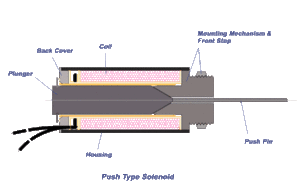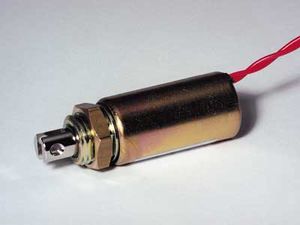Solenoids
Solenoid is a coil wound into a tightly packed helix. In physics, the term solenoid refers to a long, thin loop of wire, often wrapped around a metallic core, which produces a magnetic field when an electric current is passed through it. Solenoids are important because they can create controlled magnetic fields and can be used as electromagnets. The term solenoid refers specifically to a coil designed to produce a uniform magnetic field in a volume of space . In engineering, the term solenoid may also refer to a variety of transducer devices that convert energy into linear motion. The term is also often used to refer to a solenoid valve, which is an integrated device containing an electromechanical solenoid which actuates either a pneumatic or hydraulic valve, or a solenoid switch, which is a specific type of relay that internally uses an electromechanical solenoid to operate an electrical switch; for example, anautomobile starter solenoid, or a linear solenoid, which is an electromechanical solenoid.
Applications
Electromechanical solenoids
Electromechanical solenoids consist of an electromagnetically inductive coil, wound around a movable steel or iron slug . The coil is shaped such that the armature can be moved in and out of the center, altering the coil's inductance and thereby becoming an electromagnet. The armature is used to provide a mechanical force to some mechanism . Although typically weak over anything but very short distances, solenoids may be controlled directly by a controller circuit, and thus have very low reaction times.The force applied to the armature is proportional to the change in inductance of the coil with respect to the change in position of the armature, and the current flowing through the coil . The force applied to the armature will always move the armature in a direction that increases the coil's inductance.Electromechanical solenoids are commonly seen in electronic paintball markers, pinball machines, dot matrix printers and fuel injectors.
Rotary solenoid
The rotary solenoid is an electromechanical device used to rotate a ratcheting mechanism when power is applied. These were used in the 1950s for rotary snap-switch automation in electromechanical controls. Repeated actuation of the rotary solenoid advances the snap-switch forward one position. Two rotary actuators on opposite ends of the rotary snap-switch shaft, can advance or reverse the switch position. The rotary solenoid has a similar appearance to a linear solenoid, except that the core is mounted in the center of a large flat disk, with two or three inclined grooves cut into the underside of the disk. These grooves align with slots on the solenoid body, with ball bearings in the grooves. When the solenoid is activated, the core is drawn into the coil, and the disk rotates on the ball bearings in the grooves as it moves towards the coil body. When power is removed, a spring on the disk rotates it back to its starting position, also pulling the core out of the coil.
Rotary voice coil
This is a rotational version of a solenoid. Typically the fixed magnet is on the outside, and the coil part moves in an arc controlled by the current flow through the coils. Rotary voice coils are widely employed in devices such as disk drives.
Pneumatic solenoid valves
A pneumatic solenoid valve is a switch for routing air to any pneumatic device, usually Actuators, allowing a relatively small signal to control a large device. It is also the interface between electronic controllers and pneumatic systems.
Hydraulic solenoid valves
Hydraulic solenoid valves are in general similar to pneumatic solenoid valves except that they control the flow of hydraulic fluid , often at around 3000 psi .Hydraulic machinery uses solenoids to control the flow of oil to rams or actuators. Solenoid-controlled valves are often used in irrigation systems, where a relatively weak solenoid opens and closes a small pilot valve, which in turn activates the main valve by applying fluid pressure to a piston or diaphragm that is mechanically coupled to the main valve. Solenoids are also in everyday household items such as washing machines to control the flow and amount of water into the drum.Transmission solenoids control fluid flow through an automatic transmission and are typically installed in the transmission valve body.
Automobile starter solenoid
In a car or truck, the starter solenoid is part of an automobile starting system. The starter solenoid receives a large electric current from the car battery and a small electric current from the ignition switch. When the ignition switch is turned on , the small electric current forces the starter solenoid to close a pair of heavy contacts, thus relaying the large electric current to the starter motor. Starter solenoids can also be built into the starter itself, often visible on the outside of the starter. If a starter solenoid receives insufficient power from the battery, it will fail to start the motor, and may produce a rapid 'clicking' or 'clacking' sound. This can be caused by a low or dead battery, by corroded or loose connections in the cable, or by a broken or damaged positive cable from the battery. Any of these will result in some power to the solenoid, but not enough to hold the heavy contacts closed, so the starter motor itself never spins, and the engine does not start.

